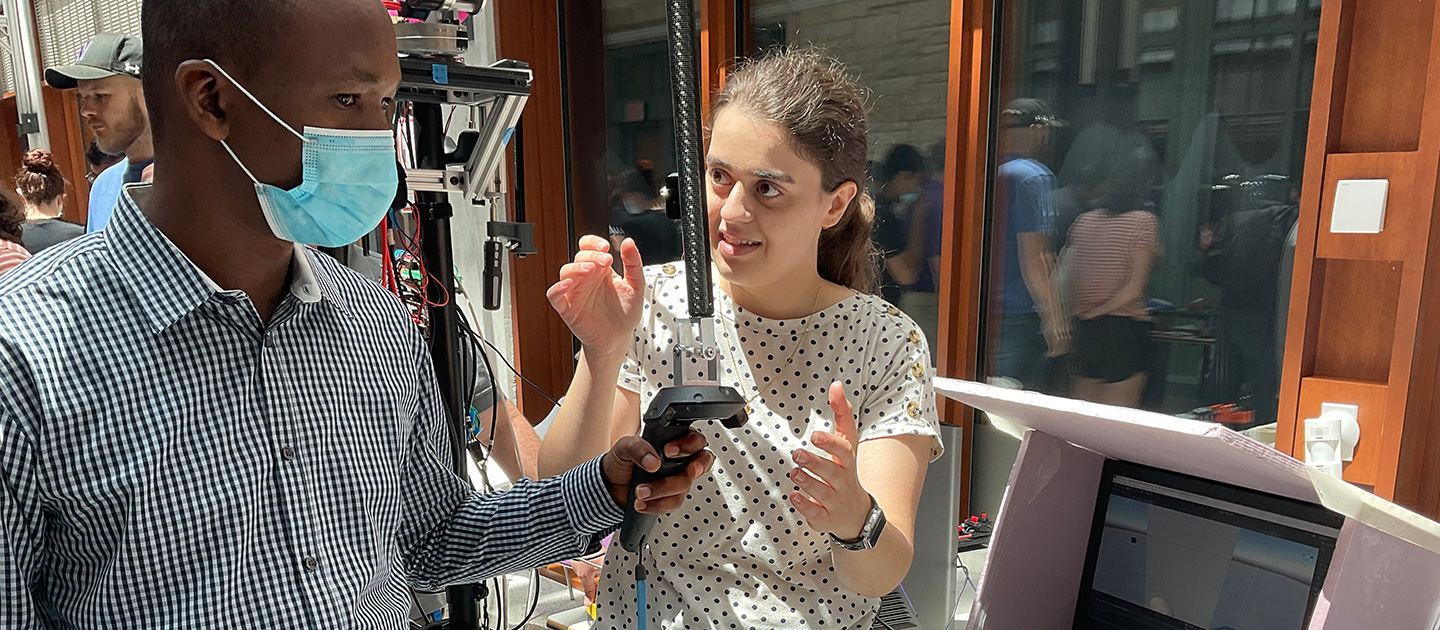Design Studio Students Show Off High-Performance Robots
Three teams from ME 472: Robot Design Studio built robotic systems with a focus on haptics

Robots that let you remotely feel textures. Interact with a virtual-reality environment. Control gadgets without touching them.
This is what visitors experienced on June 3 when three interdisciplinary student teams unveiled their robotic systems to the public.

In ME 472: Robot Design Studio, groups of undergraduate and graduate students leverage years of skills they have sharpened in CAD modeling, component sourcing, cabling/wiring, power electronics, software architecture, and more to design, build, and operate a high-performance robot.
In the two-quarter capstone course administered by Northwestern Engineering professor of mechanical engineering J. Edward Colgate, research engineer Billie Strong, and teaching assistant Thomas Trzpit, three teams with students from the mechanical engineering, computer science, robotics, and manufacturing and design engineering programs were challenged to construct robotic systems with a focus on haptics, or touch-based interfaces.
Avatar
The group built a two degree-of-freedom (independent joint) interactor robot (the avatar) and a two degree-of-freedom haptic display robot (the interface). The avatar can move a fingertip in a straight line across a surface, which varies in height and texture, while simultaneously moving the fingertip up and down so that it comes into and out of contact with the surface and can control the pressure exerted on the surface.
The interface serves as a remote control for the avatar, allowing the user to feel and explore a virtual representation of the surface. Normal forces and friction forces at the fingertip-surface interface were reproduced at the user’s fingertip with extremely high fidelity.
The team was made up of senior Kenya Alexander, senior Alyssa Chen, senior Madeline Corrigan, graduate student Zhenyu Liu, senior Daelan Roosa, and graduate student Xinyi Wang.
Tablet
The project team created a display surface (the tablet) with a pair of two degree-of-freedom robotic mechanisms (the robots) hidden behind it, as well as a pair of small pucks that rest on the tablet.
Each puck is coupled magnetically to one of the robots which can move it along the tablet surface. A user can also place fingers on the pucks and move them while feeling guidance forces applied by the robot. In this way, graphical control elements shown on the tablet could be made to feel physical.
The collaborators were senior Jose Amador, graduate student Yujui Chen, senior Diogo Costa, graduate student Yuxuan Liang, senior Cameron Mastoras, and senior Samuel Petralia.
Wand
The team created a wearable device composed of a handheld wand controller (the wand), an ergonomic device that attaches to the body (the brace), and a two- or three degree-of-freedom robotic mechanism connecting the wand to the brace (the robot). The robot produces forces relative to the brace at a single point on the wand outside the user’s hand.
This point (the cursor) serves as the interaction point in a virtual environment, and is located conveniently to permit a wide range of interactions such as drawing on a whiteboard, striking a drum, or picking up an object.
Team members were senior Reuben Grossman, graduate student Zhehao Lu, senior Ishaan Narain, senior Junior Ndayikengurukiye, senior Alexandra Sabala, and senior Eric Yang.